Fabaceae (legume family)
Legumes are a very large family of 16,000 species in nearly all of the world’s habitats. Champion drought tolerators, they are most abundant in the arid tropics. Their prevalence in the Sonoran Desert flora (for example, there are 53 legume species in the Tucson Mountains, 8% of its plants) reflects this desert’s tropical origin. North of the Mexican border most of the common Sonoran Desert trees are legumes.
Description
The family was named Leguminosae for its fruit, which in most species is a legume (the technical term for bean pod, a single-chambered capsule enclosing what appears to be a single row of seeds that is actually 2 rows—alternate seeds are attached to opposite halves of the pod). There are 3 subfamilies with flowers that look very different from one another at first glance, but arose from a common pattern:
Caesalpinia subfamily
Probably the basic pattern from which the other 2 subfamilies evolved. The flowers have 5 separate, conspicuous petals, 1 of which (the banner) is always a different size, shape, or color from the other 4. There are 10 stamens, as in nearly all legumes; in this subfamily they are separate. All species are woody. Examples include royal poinciana or arbol de fuego (Delonix regia), palo verde (Cercidium and Parkinsonia), bird-of- paradise (Caesalpinia), and cassias (Cassia).
Mimosa subfamily
The petals are fused in this group, but they’re so tiny that they are not noticeable. What one sees is a powder puff of stamens. It’s easy to visualize the derivation of flowers of this group from the above subfamily. Start with a caesalpinoid flower such as a palo verde blossom. Reduce the petals until they nearly disappear, greatly elongate the filaments of the stamens, and combine several to many flowers into a tight cluster. The visual result is a ball or cylinder of stamens (powder-puffs or catkins, respectively). All species are woody. Examples include acacias (Acacia), mesquite (Prosopis), fairy duster (Calliandra), and mimosa (Albizia).
Papilionoid (pea) subfamily
This group is characterized by 3 upper petals and 2 lower fused petals, and 9 of the 10 filaments are fused with the 10th being separate. This subfamily’s flowers diverged from Caesalpinoids in another direction from the mimosoids. Again, visualize a palo verde flower. Enlarge the banner (top) petal until it’s the largest part of the flower. Fold the two adjacent petals forward until they touch at their tips; these are called the wing petals. Finally, reduce the remaining lower two petals and fuse them along their bottom edges to form a boat-shaped structure called the keel. Conceal most of the keel between the wings, and hide the stamens and pistil inside the keel. The result is a sweet pea-shaped flower. This subfamily includes many herbaceous as well as woody species. Examples are desert ironwood (Olneya tesota), all cultivated beans (Phaseolus, etc.), lupines (Lupinus), and of course, sweet peas (Lathyrus). In a few species, such as New World coral beans (Erythrina), the banner is reduced rather than enlarged.
Notes
Plants require large quantities of three minerals: nitrogen, phosphorus, and potassium. The latter two elements are present in soil, but nitrogen is an atmospheric gas that plants cannot use directly. Some soil bacteria and cyanobacteria (blue-green algae) can fix nitrogen (convert it into nitrate or other compound) into a form which plants can use. Another major source of nitrogen is the decomposition of dead plants and animals. In arid soils especially, where decomposition of organic material is slow, plant growth is often limited by the available amount of soil nitrogen. Many legumes harbor colonies of nitrogen-fixing bacteria in their roots. The plant provides favorable habitat and carbon for the bacteria, and the bacteria in turn provide surplus nitrate to the plants. Nitrogen-fixing legumes have higher concentrations of nitrogen compounds in their tissues than non-fixing plants. When legume leaves decompose they release the nitrogen and enrich the soil. Nitrogen is an essential element in proteins, so nitrogen-fixing plants can make large crops of seeds with high protein contents (more than 50 percent in some species).
The typically large, nutritious, and abundant seeds of legumes are an important food source for many wildlife species, including insects such as bruchid beetles. Adult bruchids are flower beetles, while the larvae of most species are seed predators. Bruchids are not restricted to legumes, but there is a myriad of species that specialize on legume seeds. Some species are very host-specific, while others feed on a wide range of seeds. Decades of intensive study of the bruchid-seed relationship would likely not reveal all aspects of this tiny part of the ecological web.
Acacia constricta
English name: whitethorn acacia
Spanish names: huizache, vinorama, chaparro prieto (squat and dark), vara prieta (dark stick), gigantillo (little giant), largoncillo
Description
This acacia is a large, deciduous shrub 6 to 10 feet (2-3 m) tall with twice-compound, gray-green leaves. It can become a small tree in deep soil. Inch-long (2.5 cm), white spines are prominent on young plants; mature shrubs are often thornless. The flowers are bright yellow balls of stamens; they bloom in late spring and again after summer rains.
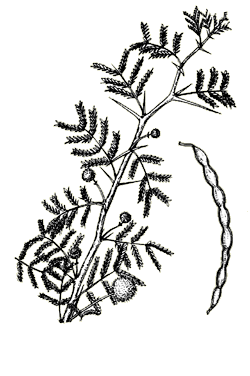 |
Range
This plant is common in the southern half of Arizona south to central Mexico and west to the gulf coast of Mexico and Texas. There are disjunct populations in northern and southern Baja California.
Notes
A. constricta’s life span is about 70 years. It is odd that the flowers advertise strongly with both bright yellow color and strong fragrance, but they offer little reward—no nectar and sparse pollen. Pollinators do not visit in large numbers, but whitethorn manages to set good seed crops. The Seri used the leaves and seeds in a medicinal tea for stomach problems.
Similar Species
Acacia neovernicosa has nearly identical foliage and flowers; it is distinguished by its sparsely-branched, erect-but-crooked stems. It’s a Chihuahuan Desert shrub.
Acacia greggii
English names: catclaw acacia,
wait-a-minute bush
Spanish names: uña de gato (cat’s claw), tésota, gatuño, palo chino (Chinese stick), tepame, algarroba
Description
Catclaw is a deciduous shrub or small tree, sometimes 20 feet (6 m) tall, but usually less than half that. The stems bear curved, very sharp prickles. Gray-green, twice-compound leaves with small leaflets are seldom dense enough to block the view through the plant. The pale yellow flowers are borne in dense, short catkins in late spring.
Range
It is common from southern Nevada south to central Baja California and southern Sonora and west to Texas and Chihuahua. Among the woody legumes, this species penetrates the farthest north and the farthest into arid habitat.
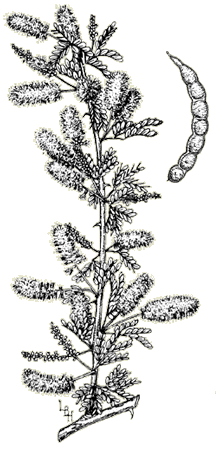 |
Notes
The O’odham drink a tea from the roots for both stomach and kidney problems. The Seri and Yaqui use the wood in bows.
The fragrant flowers, unlike those of A. constricta, produce nectar and attract many insects including bees, flies, and butterflies. Tree ring counting shows that this acacia can live at least 130 years.
Tree catclaw, A. occidentalis, is vegetatively very similar to catclaw acacia, but grows to 40 feet (12 m) tall. The inflorescences are balls instead of catkins and are extremely fragrant. Tree catclaw is nearly endemic to Sonora and occasionally found in cultivation.
Acacia willardiana (palo blanco, “white stick”) is more typical of thornscrub than desert, but needs to be mentioned because it is distinctive for several reasons. It is an upright, sparsely-branched tree to almost 30 feet (9 m) tall. Its bark is smooth and a striking white color in the finest specimens; it peels off in papery sheets. The foliage is so sparse that it casts a scarcely detectable shade. Finally, the leaves are unique among New World acacias in being phyllodes. A phyllode is a flat, expanded petiole that resembles a leaf; the real leaflets fall off soon after they’re produced. (Most of the one thousand Australian acacia species have phyllodes rather than typical leaves.) This palo blanco is endemic to Sonora, but another white-trunked legume tree in Baja California, Lysiloma candidum, is also called palo blanco.
Calliandra eriophylla
English name: fairy duster
Spanish names: cosahui, huajillo, cabeza (pelo) de ángel (angel’s head, angel’s head hair)
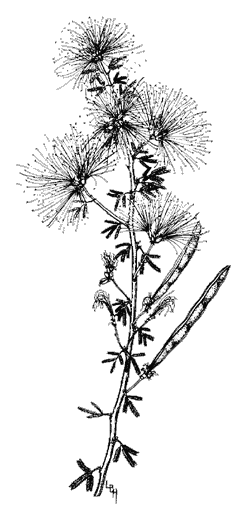 |
Description
This is a spreading shrub, usually about 2 feet (60 cm) tall and twice as wide with sparse semi-evergreen foliage of small, twice-compound, leaves. One-inch (2.5 cm) mimosoid flower heads are pale to deep pink. The plants flower profusely in late winter and sporadically at almost any season in response to good rains.
Range
Fairy duster grows from southern Arizona and southeastern California south to central Mexico and northern Baja California.
Notes
Fairy duster has several pollinators, including bees, flies, and butterflies. It is among the first perennials to bloom in Arizona Upland, typically in February.
Cercidium floridum [Parkinsonia torreyana, Cercidium peninsulare]
English name: blue palo verde
Spanish names: palo verde,
retama (bloom)
Description
Blue palo verde is a multi-trunked deciduous tree to 40 feet (12 m) tall. Terminal twigs are dense and branches droop to the ground, creating a hemispherical mound. (Floods may break off lower limbs, exposing the trunks and creating more normal-looking trees.) The bark of twigs and young branches is bluish-green. Blue palo verde has twice-pinnate leaves, each segment having only 2 to 4 pairs of relatively large leaflets. A short, straight spine is hidden beneath each leaf (often absent in mature trees). Trees flower for 2 weeks in mid-spring, usually April in Arizona Upland. The bright yellow flowers are produced in such profusion that they completely conceal the branches. The banner petal is slightly larger than the other 4 and has small orange dots. Pods contain 1 or 2 flattened, extremely hard seeds the size of small lima beans.
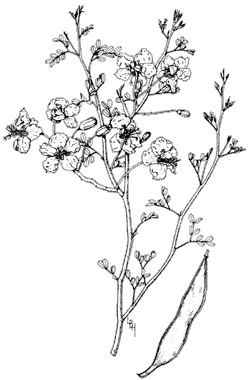 |
Range
This tree occurs from southern Arizona and southeastern California to northern Sinaloa. It also occurs in the southern half of Baja California, but not in the north, presumably due to the north’s extreme aridity. In most of its range this is a dry-riparian species, restricted to washes because it needs more water than is provided by rainfall. Just after the last Ice Age the climate was wetter than today, and blue palo verdes grew beyond the washes as foothill palo verdes do today.
Notes
The green bark color of palo verdes is due to chlorophyll-bearing tissue. As do many other species, these trees conserve water by dropping their leaves during dry seasons, but palo verdes can still carry on some photosynthesis. Blue palo verde also drops its leaves in response to cool autumn temperatures.
The flowers are pollinated by numerous species of solitary bees that gather pollen and cache it in burrows for their grubs to feed on. The main palo verde bee is Centris pallida, but there are 6 other species of Centris that visit palo verdes, in addition to sweat bees, several leaf-cutter bees, bumblebees, and carpenter bees. Bee specialist Bob Schmalzel casually identified about 20 different species of bees foraging in a single palo verde tree at the same time.
Mature pods fall and remain under the trees for several weeks, where bruchid beetle larvae consume many of the seeds. Javelina and rock squirrels are among the few other animals that commonly eat the very hard seeds. A band of javelina feeding on these beans sounds like a rock crusher; the noise carries a considerable distance. Most indigenous peoples did not eat the seeds, but they are a fairly important food source for the Seri, who grind them into flour. Freshly-matured seeds with hardened seed coats are impermeable to water; they cannot germinate until the seed coat is either scarified by a flash flood or weathered for a few years in the soil.
Blue palo verde is fast-growing and fairly short-lived. Plants in cultivation seem to become senescent after about 30 years, and probably don’t live as long as a century in the wild. The soft wood makes poor lumber. It is also poor for firewood, burning rapidly while emitting a strong, unpleasant odor, and making no coals.
Cercidium microphyllum [Parkinsonia microphyllum]
English names: foothill palo verde,
littleleaf palo verde, yellow palo verde
Spanish names: palo verde, lebón
retama, palo brea (tar stick)
Description
Foothill palo verde is a multitrunked, deciduous, large shrub or small tree to about 15 feet (4.6 m) tall, rarely to 30 feet (9 m) in deep soils. The yellowish-green branches are stiff and strongly upright, not drooping as in blue palo verde. Leaves are twice-pinnate, each fork bearing 3 to 5 pairs of tiny leaflets. Foliage is sparse even at the peak of the rainy season, and absent during the dry season. There are no spines beneath the leaves as in blue palo verde, but each twig terminates in a thorn. The tree flowers profusely for 2 weeks in late spring, beginning just as blue palo verdes in the same area are finishing. Flowers are less bright than those of blue palo verde; the petals are pale yellow and the banner is white. The pods contain 2 to 4 or more navy-bean sized seeds with thinner, softer shells than those of blue palo verde.
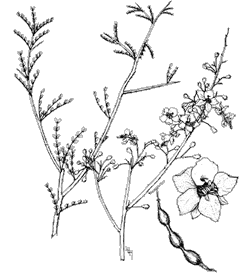 |
Range
This plant occurs almost throughout the Sonoran Desert except in the driest regions at the head of the Gulf of California and in the state of California where there is insufficient summer rainfall.
Notes
See blue palo verde for information about photosynthesis and pollination. Foothill palo verde is more drought resistant than blue palo verde; it is not restricted to washes and is common on rocky hillsides. These very slow-growing trees are more than a century old at maturity, and desert ecologist Forest Shreve thought they could live up to 400 years. (Palo verdes do not make growth rings, so age-dating by counting rings is not possible.) The thin-shelled seeds do not require scarification to germinate. After maturing and falling they are quickly gathered and consumed by a variety of rodents and other seed eaters. Antelope ground squirrels and pocket mice are major seed dispersers. They bury seeds for later consumption; burial terminates reinfestation by bruchid beetles and preserves the viability of uninfested seeds. Seeds that have not been retrieved and eaten germinate when the summer rains come.
Humans have also relied on the seeds for food; crops are abundant in most years. The O’odham preferred to eat the green seeds or pods; young seeds are tender and taste much like fresh peas. The Seri ate the fresh green seeds and also toasted, ground, and ate the mature seeds in a gruel. They usually raided pack rat nests to obtain the mature pods, and then winnowed the seeds.
Four species of palo verde grow in the Sonoran Desert and sometimes naturally hybridize. Foothill palo verde hybridizes fairly commonly with Mexican palo verde (Parkinsonia) where both species grow in proximity. There are a handful of foothill/blue palo verde hybrids in the Tucson area and probably elsewhere. A single hybrid of blue and Mexican palo verdes is documented (blooming seasons rarely overlap). Hybrids with desirable traits are being propagated, notably the complex hybrid ‘Desert Museum’ palo verde, which is erect, fast-growing, thornless, long-blooming, and relatively tidy.
Lupinus spp.
English name: lupine
Spanish names: lupino, altramuz
Description
Lupines number about 200 species of annual and perennial herbs and semiwoody shrubs worldwide. Our desert species are all annuals. Lupinus sparsiflorus (now including L. arizonicus) has palmate leaves and flowering spikes about a foot (30 cm) tall. The blue to purple pea-shaped flowers are about a ¼-inch (13 mm) long, usually bloom in March in Arizona Upland.
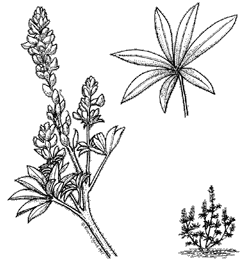 |
Range
One or more species of lupine can be found in nearly every habitat in the Sonoran Desert region. Lupinus sparsiflorus is widespread in the Mohave and northern Sonoran deserts.
Notes
Lupines are among the 3 most common showy spring annuals of Arizona Upland. They cover many square miles of desert in wet years.
In some parts of the world lupine seeds are gathered and eaten. But some species have toxic seeds, and Lupinus sparsiflorus is especially poisonous. Neither the Seri nor O’odham have a practical use for lupine, but both cultures know it well enough to have named it for its sun-tracking habit. The hand-shaped leaves move to face the sun all day, then fold up at night. The Seri name means “sun-watcher” and the O’odham name means “sun-hand.”
Olneya tesota
English name: desert ironwood
Spanish names: palo fierro
(iron stick), tésota, palo de
hierro (iron stick), comitín
Description
Desert ironwood is a tree up to 35 feet (11 m) tall with twice-compound leaves and a pair of sharp, curved spines at each node. The nearly evergreen foliage is dense and deep green in wet years, sparser and gray-green during drought. In the extremely arid islands in the central Gulf of California the trees become completely leafless at times. Mature trees also shed their leaves a few weeks before flowering in May, then re-leaf when the summer rains come; only limbs that will flower drop foliage. Bloom is heavy only about 2 out of 5 years. The pea-shaped flowers are usually pale lavender, but occasionally rich purple-violet. The flowering period is brief, lasting 10-18 days.
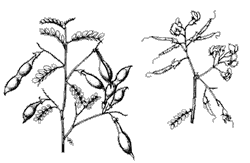 |
Range
Desert ironwood ranges throughout the Sonoran Desert and is almost completely confined to it. Cold air drainage restricts it to the warmer slopes above valley floors in Arizona Upland. Seedlings cannot establish where temperatures regularly fall below 20°F (-6°C). In the most arid subdivisions, such as Lower Colorado River Valley, it is restricted to washes.
Notes
The seeds are eaten by many animals; they are fairly soft-shelled, taste somewhat like peanuts (another famous legume), and are high in protein. They are mildly toxic and probably should not be eaten in quantity without proper preparation. The Seri cook them in 2 changes of water.
Desert ironwood replaces palo verde and mesquite as the major nurse tree in the Central Gulf Coast and parts of the Lower Colorado River Valley subdivisions. In those habitats 165 species have been documented having ironwood as nurse trees, and some of them require this species.
Desert ironwood grows slowly and lives long. Unlike many other trees, desert ironwood’s rings are often incomplete or missing, so reliable counting to determine exact age is not feasible. On the basis of long-term observations, some botanists estimate that the trees can live for at least 300 years, and perhaps twice that. One ancient-looking tree at the Desert Museum was determined by carbon-dating to be about 180 years old. In more arid habitats some trees are very likely to be much older.
Decomposition after death is extremely slow. The dark-colored heartwood is rich in toxic chemicals and essentially non-biodegradable; it physically weathers away over many centuries. Dead trees can remain standing for a millennium; small firewood-sized chunks have been carbon-dated at 1600 years.
The wood is extremely dense; it will not float in water. (There are several such trees in the world that are called ironwood, so the full name desert ironwood should be used to avoid confusion.) It’s the favorite wood used by the Seri Indians to make their famous wood carvings. This craft developed in the early 1960s for tourist trade purposes; more recently, non-Seri neighbors of the Seris in Mexico have mass-produced similar (but often cruder) figures.
Desert ironwood makes excellent firewood; it burns long and hot and makes good coals. Harvest for woodcarvings and charcoal has nearly extirpated large trees in most of Sonora, and campers and illegal woodcutters are depleting accessible populations in the United States. Because of this and their slow growth rate, it is no longer ethical to burn desert ironwood. It is also illegal; this tree is protected in both Sonora and Arizona.
Parkinsonia aculeata
English names: Mexican palo verde, Jerusalem thorn, retama
Spanish names: bagote, junco marino, cacaporo, guacóporo, retama, palo verde, mezquite verde, espinillo
Description
This is a tree with strongly ascending branches to 40 feet (12 m) tall with sparse foliage that casts little shade. The leaves are very large, each consisting of up to 4 narrow pinnae up to a foot (30 cm) long. Each pinna (plural pinnae) of this tree is a narrow leaf axis bearing 2 rows of leaflets, somewhat resembling its namesake—a feather. The 10 to 40 pairs of tiny leaflets fall off at the first sign of water stress. The pinnae are shed during more severe droughts. There are 2 long, sharp spines at the base of each leaf; these are sometimes forked on vigorous growth. The bright yellow flowers are borne profusely for a month or more in late spring, and sporadically during the other warm months. The banner of older flowers is orange. Pods usually contain 3 or more seeds.
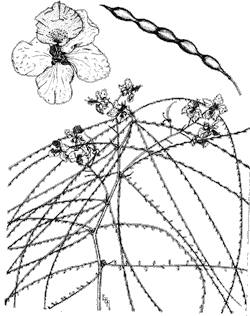 |
Range
This tree is native to the New World tropics and has been introduced worldwide. It was probably introduced to Arizona, where it is primarily associated with human-altered sites such as vacant lots and roadsides.
Notes
Though it can grow 8 feet (2.4 m) a year, Mexican palo verde has numerous drawbacks as a residential tree. The vicious spines make pruning an unpleasant chore. The long, stringy leaves are too sparse to cast useful shade and are shed in great quantities that create a continuous mess beneath the tree, especially when they become lodged in other landscape plants. Lastly, seedlings volunteer aggressively, and trees don’t live longer than about 30 years.
Mesquites
Prosopis velutina [Prosopis juliflora var. velutina]
English name: velvet mesquite
Spanish names: mezquite, algarroba, chachaca, péchita (pods only)
Prosopis glandulosa var. torreyana [Prosopis juliflora var. torreyana]
English name: honey mesquite
Spanish names: mezquite, algarroba, chachaca
Following Lt. Edward Beale’s exploration of the Chihuahuan Desert in the 1850s, his report touted mesquite as the key to settling the West. It was superb for lumber, firewood, and food and shelter for both man and livestock. He was correct, but he was ahead of his time. It’s ironic that many ranchers today consider mesquite a rangeland pest, especially in Texas.
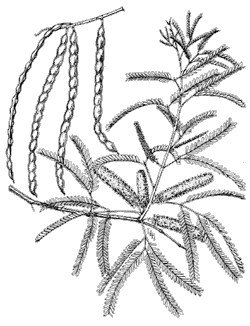 |
Description
Both of these mesquites are deciduous large shrubs or trees. Honey mesquite grows 10 to 30 feet (3-9 m) tall; velvet mesquite may attain 55 feet (17 m). Honey mesquite usually has 2 pinnae with smooth or hairy, bright green leaflets. Velvet mesquite usually has 4 pinnae with fuzzy, dull green leaflets. The inflorescences are clusters of pale yellow catkins about 3 inches (7 cm) long. They bloom in spring and sometimes again in midsummer. Flattened, non-splitting pods are about 8 inches (20 cm) long, consisting of 3 distinct parts. Each of several lentil-shaped seeds is enclosed in a very durable woody capsule, the endocarp. Between the thin skin (exocarp) and endocarp is the mesocarp, a mealy pulp. Mesquite pods are thus not technically legumes (bean pods), but the trees are still in the legume family because of the flower structure.
Range
Both species occur mainly below 5000 feet (1500 m) elevation. Honey mesquite is widespread in Arizona, Sonora, and Baja California, and the desert habitats of California. Velvet mesquite is found only in Arizona and Sonora. The 2 species hybridize where they occur together. (Texas honey mesquite, P. glandulosa var. glandulosa, occurs from New Mexico to Trans Pecos Texas. It has recently colonized Arizona along I-10; the seeds are being dispersed by trucks transporting cattle and their seed-laden cowpies from Texas to California.)
Notes
The flowers are pollinated mainly by bees, and the resulting pods are produced in huge quantities in good years. Fallen pods are quickly infested with bruchid beetle larvae, and eaten by a variety of larger animals. Germination is enhanced by passage through the guts of large animals; otherwise a few years of weathering is needed to release the seeds from the endocarp. The foliage is also an important browse for numerous animals. Mesquite is long-lived, probably a couple of centuries in favorable sites.
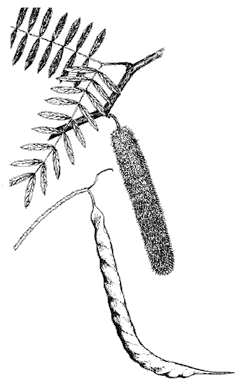 |
The mesquite’s root system is the deepest documented; a live root was discovered in a copper mine over 160 feet (50 m) below the surface. Like all known trees, however, 90% of mesquite roots are in the upper 3 feet of soil. This is where most of the water and oxygen are. The deep roots presumably enable a mesquite to survive severe droughts, but they are not its main life support.
Dense mesquite stands are called bosques (pronounced BOSE case). Once abundant on floodplains in the southwest U.S., most have been cut down or killed by rapid lowering of water tables. Only scattered remnants still exist. In the low desert, velvet mesquite is restricted to flood plains and large washes. At higher elevations it also occurs on dry hillsides. On the rocky slopes of Arizona Upland it is sparse and dwarfed to shrub size.
Understanding the natural habitat and ecology of mesquite in southern Arizona requires a deep time perspective. Mesquite coevolved with large herbivores, such as mastodons and ground sloths, which ate the pods and then dispersed them widely in their feces. The bruchid seed parasites were killed by the gut juices, greatly increasing seed viability. When this Pleistocene megafauna became extinct about 10,000 years ago, mesquite’s range largely contracted to flood plains and washes, where seeds were scarified by floods or weathered in wet soil. Climate was also influential, since mesquite persisted on the slopes of the Waterman Mountains west of Tucson until 3800 years ago.
The introduction of cattle to North America refilled the vacant ecological niche of the extinct native herbivores, and mesquite began recolonizing its former hillside habitats. Many ranchers viewed this range expansion as an undesirable new invasion and attempted to eradicate the plant. A low density of mesquite trees in grassland is actually beneficial to livestock and wildlife; grass growing beneath these trees is more nutritious and remains green longer into the dry season. The shade is also beneficial for large animals. On the other hand, overgrazing causes a reduction in fire that controls mesquite populations in grassland; this allows the trees to become so numerous that they exclude grasses. Because dense mesquite outcompetes grass for water and light and because mesquite groves don’t support fire, this conversion is permanent (on a human time scale) without physical intervention.
Velvet mesquite has been a major food source for indigenous peoples. The mesocarp is sweet, containing 20 percent to 30 percent sugars in the best trees. (The pods of honey mesquite are bitter.) The seeds contain about 35 percent protein, more than soybeans, though it’s difficult to separate them efficiently from the inedible endocarp. Mesquite meal (the mesocarp) is tasty as well as sweet, and its popularity in modern cuisine is increasing. Pod production is sufficient to make mesquite commercially viable as a cultivated crop; research and development toward this end are ongoing. The Tohono O’odham appear to be on the verge of commercial success with this crop. Mesquite flour also has major conservation potential, in that it can be made into “bread”without baking. Most of the world’s people cook over wood fires, and demand for fuel-wood is a major cause of deforestation.
The wood is hard, attractive, and in high demand for quality furniture. The sapwood is yellow, the heartwood rich reddish-brown. It is evermore expensive now that most of the great bosques have been lost to habitat destruction.
Mesquite has recently surpassed hickory as the most popular smoke flavoring for food. Because of the overharvesting, its wood should not be used for this purpose; burning dried pods imparts the same flavor.
The inner bark furnished both Indians and early settlers with material for basketry, coarse fabrics, and medicine to treat a variety of disorders. Gum exuded from the stem is used for manufacture of candy (gumdrops), mucilage for mending pottery, and black dye.
Senna covesii and S. bauhinioides [Cassia spp.]
English name: desert senna
Spanish names: dais, hoja sen, rosamaría (rosemary)
Description
Both species are small subshrubs with fuzzy gray-green leaves. They are most easily distinguished by the number of leaflets; S. bauhinioides has 2, S. covesii has 4 or 6. Foliage is shed during dry seasons. Rains trigger short spikes of yellow caesalpinoid flowers, mostly in spring and late summer.
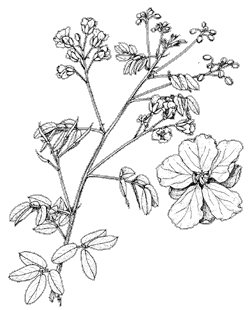 |
Range
Both species are widespread in the Sonoran Desert and into the arid tropics of Mexico. Their ranges overlap in Arizona.
Notes
These and other sennas are buzz-pollinated by large carpenter bees and bumblebees. The anthers of buzz-pollinated flowers don’t split open lengthwise to expose their pollen as in most flowers. Instead each anther has a small pore at one end that is too small for even the smallest insects to enter. The flower is so oriented that the bee lands on it hanging upside down with the anther pores facing downward. The bee then vibrates its wing muscles, making an audible buzzing sound different from that of the bee in flight. The pollen is thus shaken out of the anthers onto the hanging bee. The pollen grains are tiny and nonsticky to prevent them from clogging the anther pores. Carpenter bees have especially fine hairs on their bodies for catching this pollen. As the bees visit other flowers, some of the pollen on their bodies gets stuck on the stigmas and effects pollination.
In addition to the sennas, a number of plants in the nightshade family (Solanaceae) are buzz-pollinated, including tomatoes. Though they are self-fertile, tomato flowers must be buzzed—ordinarily by wild bees— to dislodge pollen so that it falls onto the stigmas. As recently as the 1980s, greenhouse growers hired workers to vibrate the flowers with electric toothbrushes to ensure fruit set. Today they purchase commercially-produced bumblebee hives. The bees are not only more efficient pollinators than humans with toothbrushes, they are also less expensive.










